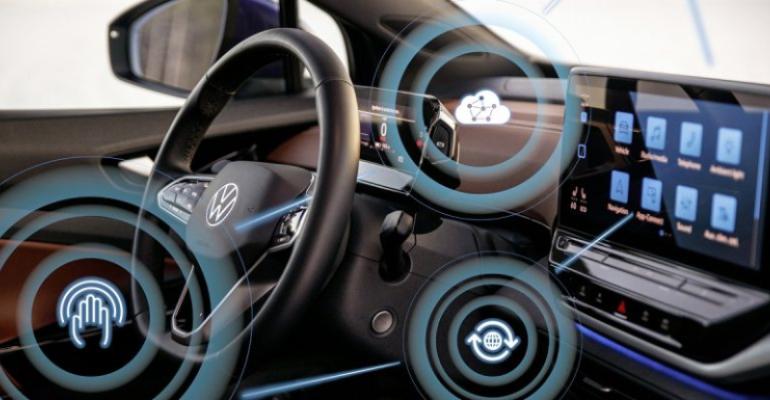The software-defined vehicle has arrived.
Now automakers and Tier 1 suppliers are weighing whether personalization and customization for consumers will turn out to be the industry’s Holy Grail. Technological changes and updates were once incremental but the cycle has accelerated from gradual modifications and ad hoc software additions to real-time upgrades.
“The car has evolved by bolting on new parts, add a feature that doesn’t necessarily integrate with anything else, that was a fixed function,” said Danny Shapiro, vice-president of automotive at Nvidia. He notes this is changing with the move to a software-defined car: “It’s about bringing high-performance computing into the vehicle and planning for the future, to run applications that haven’t been envisioned yet, with over-the-air updates to run them.”
Nvidia and other suppliers are working with carmakers on future proofing vehicles by bringing greater computer power on board designed to eventually run applications that haven’t even been created. The company’s Nvidia Drive Orin platform aims to operate as the software-defined vehicle’s brain. It powers computing functions including a visualization of autonomous driving functions, digital clusters, infotainment, and passenger interaction AI.
Shapiro says that software-based platforms such as Nvidia’s will offer versatile, AI assistance for drivers and passengers. These on-board assistants will learn schedules, routes, and other external facts but will also “know” who is in the car, what their preferences are for climate and entertainment, and be able to converse with occupants, not simply answer with canned responses.
Are you experienced?
Automakers have long focused and traded on engineering prowess, design and luxury. In a recent report, McKinsey wrote: “These qualities still matter to today’s consumers but they are table stakes. The new battleground is increasingly one where tech-enabled, data-rich, EV companies currently have the upper hand: customer experience superior driving performance and vehicle reliability.”
While boosting budgets to implement integrated tech platforms, the consultancy suggested auto manufacturers take an easy route to cut costs: complexity reduction. McKinsey noted one European premium brand had more than 100 different interior configurations compared to a US EV maker that offers just two configurations.
The report also advised carmakers to consider using docking stations for mobile devices. Many automakers have long used a BYOD approach, since it offers consumers a familiar interface to access their apps and communicate, when appropriate and safe to do so. Auto executives who back BYOD have long seen this as an easy way to please customers while saving money, although some designers say there’s still a way to go before in-car consumer customization quiets critics.
“Services like CarPlay and Android Auto have enhanced the ability to mirror what my phone can do in the car… but the rock in the shoe of the consumer is that a vehicle can only accommodate a small percentage of personalization that exists in the consumer’s life,” Eric Noble, President, The Carlab told TU-Automotive. Noble added the opportunity for that level of personalization is “vast” but that automakers must balance offerings with safety: “We can’t have the level of distraction or screen interaction we have on mobile devices for good reasons. We have to balance technology that changes daily versus human nature that changes never.”
Pilot of the airwaves
One manufacturer that has long traded on its tech background and cutting-edge capabilities is Tesla. The EV maker’s recent over-the-air (OTA) Software V11.0 update underscores why all parties in the auto supply chain are excited about more widespread use of this functionality. The free OTA offers a range of novel options and functionality including new infotainment experiences, safety features, customizable controls and a new user-interface design. Gene Munster of Loup Funds wrote in a note to clients that the EV maker’s moves are “net positive”, adding that the new UI creates the foundations for “future user customization and highlights the potential for an app store.”
These types of OTA updates will play larger roles for all automakers down the road, allowing for carmakers to release new models and features while continuing to do research even after the vehicle has rolled off the lot. In fact, Shapiro predicts: “The car being at its worst the day you take delivery and it gets better and better over time. The value of the car may go up over time because it can do things it couldn’t when you bought it.”
Noble said: “OEMs are captivated and intensely focused on OTA for one reason: the dream of ongoing revenue potential.” Noble, who works with all major German, Korean and Japanese manufacturers as well as US Tier 1s, added that OTA fees are a more realistic and reliable revenue stream than collecting and selling consumer data from vehicles. “It’s an OEM fantasy that they’ll sell data based on the connected car. Consumers have no interest in any of that.”
The design executive is much more confident about consumer uptake and interest in advanced driving and safety technology: “OEMs can’t develop driver systems fast enough and consumers have invariably paid for them. Once systems like lane departure and auto emergency braking are in and work, consumers embrace it and pay for it. We’re extremely bullish on ADAS and autonomy because consumers are.”





